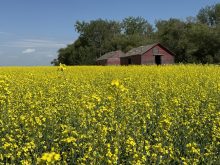Two independent groups of farmers have announced plans to build pulse processing plants in Saskatchewan to help clean and bag what is expected to be a record crop this year.
Mainline Pulse Inc. is already under construction in Chaplin, while the backers of a $2 million facility in Vanguard are finalizing plans for Notukeu Processing Inc.
According to Saskatchewan Agriculture’s calculations, that will bring the number of planned and existing special crops processors in the province to 137.
Most of the plants are small mom-and-pop type shops or facilities that are owned by groups of local farmers. The big players in the grain industry don’t have the presence they do in conventional grain processing.
Read Also

Alberta Beef Producers announces withdrawal from Canadian Cattle Association
Glacier FarmMedia – On August 12, 2025, the Alberta Beef Producers (ABP) announced their decision to withdraw their membership from…
Saskatchewan Wheat Pool, the largest grain handler in the country, owns only four special crops processing facilities in the province — in Humboldt, Moose Jaw, Rosetown and Kindersley.
The pool jointly owns two other facilities, Regina Seed Processors in Richardson, Sask., and Lakeside Processors Ltd., in Dafoe, Sask.
“It tends to be a business that lends itself to small operators and what traditionally happens is that most of these small operators custom clean for the larger grain companies,” said Will Hill, senior vice-president of the pool’s grain group.
Although the pool does a “considerable amount” of processing at its own facilities, it also contracts work to 10 independent plants throughout the province, said Hill.
“We kind of bring the origination side and the export side to the business and they look after the processing. It’s actually quite a good relationship.”
Hill said the kind of processing required by special crops doesn’t lend itself to large-scale plants. The operations have to be flexible because there is a lot of switching from one product to another on a daily basis.
They use slower cleaning units that don’t require much capital investment or storage capability because farmers tend to hang onto the product until it’s ready to be processed.
“On a per tonne basis, the small operator can operate very efficiently and they’re happy to do custom processing.”
Small and flexible worked until now, but new processing plants are larger, more sophisticated facilities. There is a trend to higher volume and more specialized operations.
The plant under construction in Chaplin, for instance, will have two independent processing lines, one for round seeds such as peas and chickpeas and another for flat seeds such as lentils. The round seeds processing line will also be able to separate kabuli chickpeas according to size.
It will be capable of cleaning more than 200,000 tonnes of crop a year, far exceeding the average processing volume of just under 15,000 tonnes. And it will use a dual rail spur to load up to 36 rail cars.
Raymond Van De Woestyne believes there is plenty of room for larger plants like this in Saskatchewan. They will replace some of the smaller, outdated facilities scattered around the province.
His company, VCM Management Group Ltd., designs and builds processing plants. It recently built the Southland Pulse Inc. plant in Estevan, Sask.
Van De Woestyne would like some of these new plants to take the next step in processing.
“They’re not making a lot of money being custom cleaners. There’s a few operators out there that are making more money by going up the food chain and they’re splitting and sorting.”
According to a 1999 survey conducted by Saskatchewan Agriculture, 97 percent of the special crops processing activity in the province is cleaning, bagging and bulk loading. Only two percent of the volumes processed were split and color sorted.
“We have to not only just clean and bag it, we have to make it food-ready,” said Van de Woestyne.
He spent last year doing the groundwork for a massive Turkish-funded pulse processing plant to be located in Saskatoon. Those plans fell through when the backers were jailed for cheating the Turkish government out of millions of dollars in import-export taxes.
“I think whoever puts in a canning line for peas will be king. I’m sure somebody is looking at it but nobody has done it yet,” Van de Woestyne said.
Bert Vandenberg, pulse breeder at the University of Saskatchewan’s Crop Development Centre, said many are rushing to build new plants while there is still undercapacity.
Pulse acreage in Saskatchewan has grown more than 10 fold in the last decade. Statistics Canada’s survey of planting intentions shows growers plan to seed 4.9 million acres in 2001, up from 4.6 million acres last year.
“It’s hard to know when (the processing) will catch up,” said Vandenberg.
He said plants designed to handle 20,000 tonnes of crop are now inadequate. There is a definite trend for bigger, more specialized facilities that handle only green peas or only chickpeas and red lentils.















